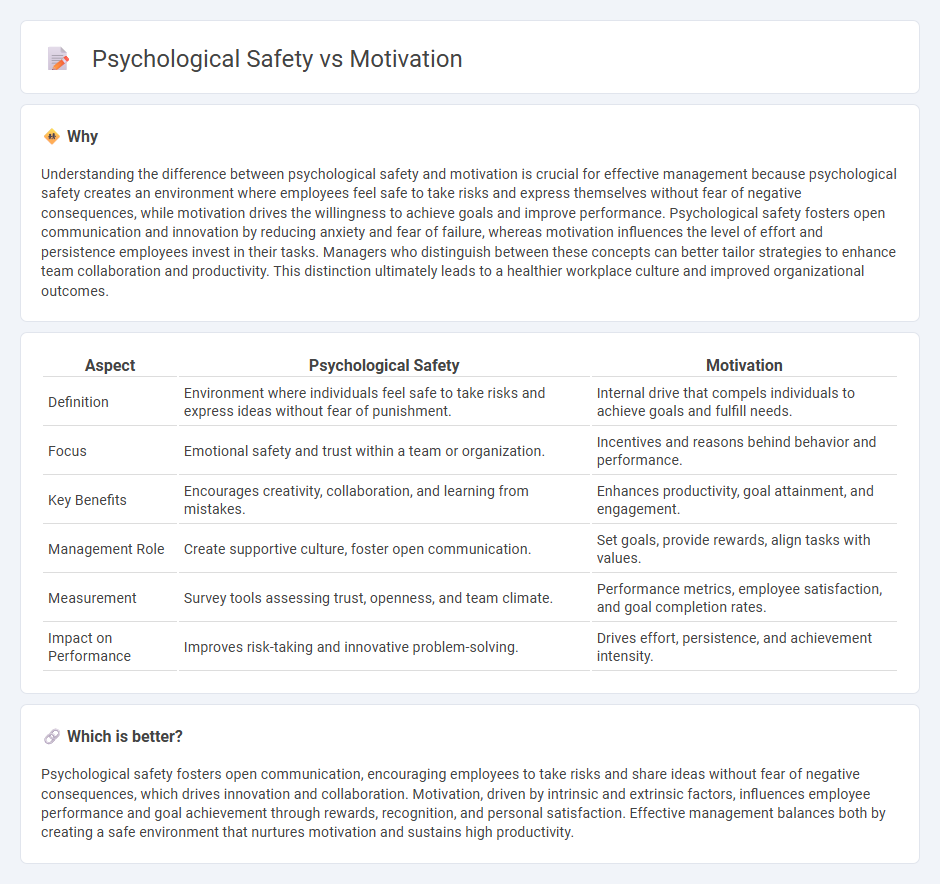
Psychological safety is the shared belief that a team environment is safe for interpersonal risk-taking, fostering open communication and innovation. Motivation drives individuals to achieve goals through intrinsic and extrinsic factors, influencing productivity and engagement. Explore the relationship between psychological safety and motivation to enhance effective management strategies.
Why it is important
Understanding the difference between psychological safety and motivation is crucial for effective management because psychological safety creates an environment where employees feel safe to take risks and express themselves without fear of negative consequences, while motivation drives the willingness to achieve goals and improve performance. Psychological safety fosters open communication and innovation by reducing anxiety and fear of failure, whereas motivation influences the level of effort and persistence employees invest in their tasks. Managers who distinguish between these concepts can better tailor strategies to enhance team collaboration and productivity. This distinction ultimately leads to a healthier workplace culture and improved organizational outcomes.
Comparison Table
| Aspect | Psychological Safety | Motivation |
|---|---|---|
| Definition | Environment where individuals feel safe to take risks and express ideas without fear of punishment. | Internal drive that compels individuals to achieve goals and fulfill needs. |
| Focus | Emotional safety and trust within a team or organization. | Incentives and reasons behind behavior and performance. |
| Key Benefits | Encourages creativity, collaboration, and learning from mistakes. | Enhances productivity, goal attainment, and engagement. |
| Management Role | Create supportive culture, foster open communication. | Set goals, provide rewards, align tasks with values. |
| Measurement | Survey tools assessing trust, openness, and team climate. | Performance metrics, employee satisfaction, and goal completion rates. |
| Impact on Performance | Improves risk-taking and innovative problem-solving. | Drives effort, persistence, and achievement intensity. |
Which is better?
Psychological safety fosters open communication, encouraging employees to take risks and share ideas without fear of negative consequences, which drives innovation and collaboration. Motivation, driven by intrinsic and extrinsic factors, influences employee performance and goal achievement through rewards, recognition, and personal satisfaction. Effective management balances both by creating a safe environment that nurtures motivation and sustains high productivity.
Connection
Psychological safety enhances motivation by creating a work environment where employees feel secure to take risks and express ideas without fear of negative consequences. This sense of safety boosts intrinsic motivation, leading to increased engagement, creativity, and productivity. Organizations with high psychological safety typically experience lower turnover rates and higher team performance due to motivated and empowered employees.
Key Terms
Intrinsic Motivation
Intrinsic motivation thrives in environments where psychological safety allows individuals to express ideas and take risks without fear of negative consequences. Psychological safety fosters autonomy, mastery, and purpose, which are core drivers of intrinsic motivation. Explore how enhancing psychological safety can significantly boost intrinsic motivation in teams and organizations.
Trust
Motivation thrives in environments where psychological safety fosters trust, allowing individuals to take risks and share ideas without fear of judgment or reprisal. Trust acts as the foundational catalyst that enhances both intrinsic and extrinsic motivation by creating a secure space for growth and collaboration. Explore how building trust within teams transforms motivation and psychological safety for superior performance.
Belonging
Motivation drives individuals to achieve goals, while psychological safety fosters a secure environment where team members feel a sense of belonging essential for collaboration and creativity. Belonging enhances intrinsic motivation by reducing fear of judgment, encouraging open communication and risk-taking. Explore how cultivating psychological safety can amplify motivation through deeper belonging.
Source and External Links
Motivation - This webpage provides an overview of motivation, including its definition, theories like goal-setting and self-determination, and factors influencing motivation.
Motivation: How to get started and staying motivated - This article outlines key facts about motivation and offers tips for getting started and maintaining motivation, including setting achievable goals and seeking support.
Motivation: The Scientific Guide - This comprehensive guide covers the science behind motivation, debunking common misconceptions and providing practical tips on how to cultivate consistent motivation.
 dowidth.com
dowidth.com